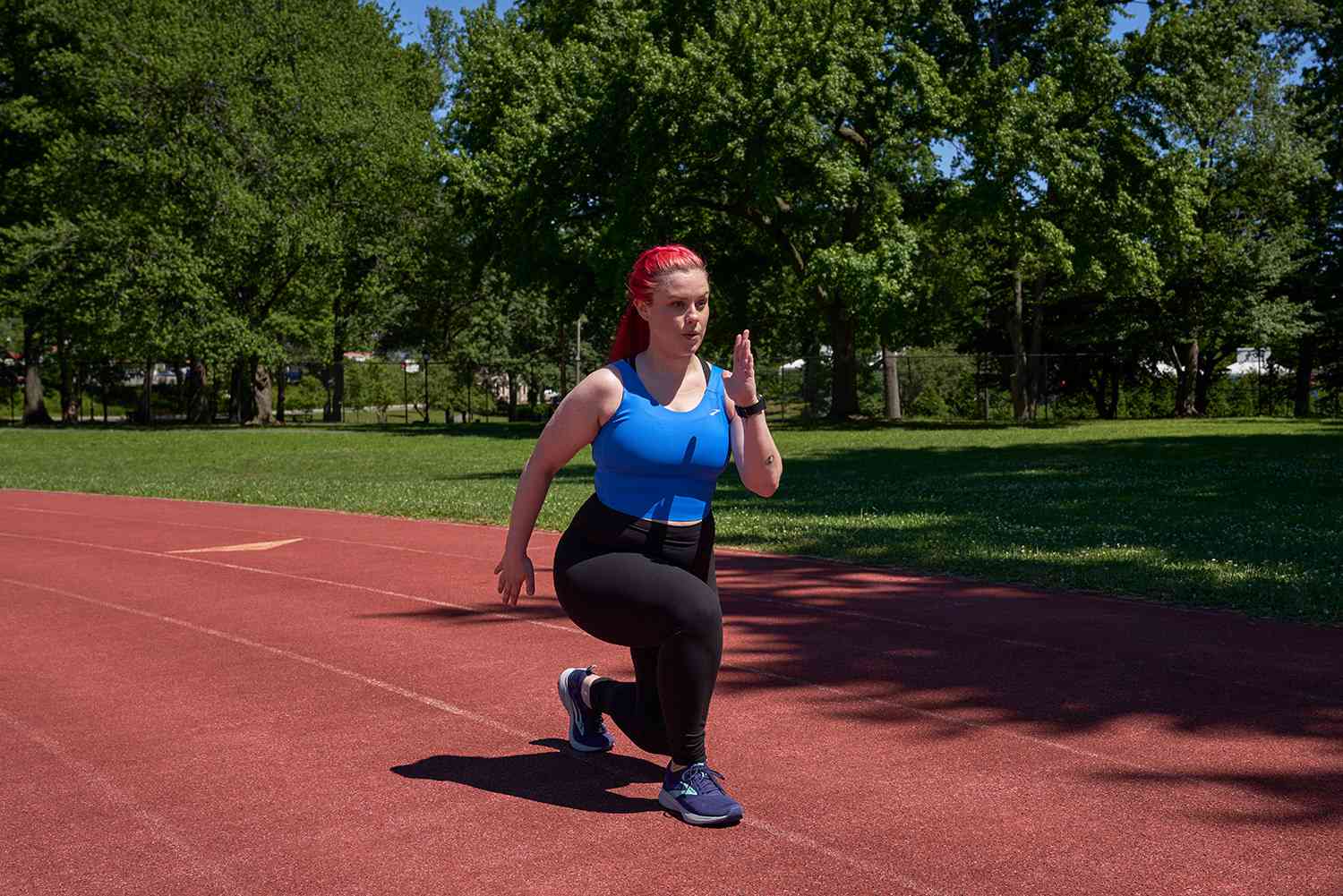Home>Misc>Featured>How To Improve Speed In Long Distance Running


Featured
How To Improve Speed In Long Distance Running
Modified: January 22, 2024
Looking to improve your speed in long distance running? Check out our featured tips and techniques to help you reach your goals faster.
Introduction
Long distance running is a challenging yet rewarding sport that requires not only endurance, but also speed. While endurance is important to sustain your pace over the course of a long run, speed is essential to improve your performance and achieve personal goals. Whether you’re a beginner looking to increase your running speed or an experienced runner aiming to set a new personal record, there are several strategies and techniques that can help you improve your speed in long distance running.
Speed in long distance running not only allows you to cover more ground in less time, but it also helps you maintain a consistent and efficient running form. By increasing your speed, you can overcome physical and mental barriers, push your limits, and accomplish feats you never thought possible. However, improving speed in long distance running is not just about running faster—it requires a combination of proper training techniques, physical conditioning, and mental preparation.
In this article, we will explore various methods and strategies to help you improve your speed in long distance running. We will discuss the importance of speed in long distance running and how it affects your overall performance. Additionally, we will provide practical tips on evaluating your current running speed, setting realistic goals for improvement, and correcting your running form. We will also delve into specific training methods such as interval training, tempo runs, and endurance building, as well as techniques for strengthening your legs and implementing proper breathing techniques.
By incorporating these strategies into your training routine and staying consistent, you can enhance your speed in long distance running and achieve your desired goals. So, lace up your running shoes and let’s embark on a journey to improve your speed in long distance running!
Understanding the Importance of Speed in Long Distance Running
When it comes to long distance running, many people assume that speed is not a crucial factor. After all, isn’t endurance the key to success in marathons and half-marathons? While it is true that long distance running requires significant endurance, speed plays a vital role in improving overall performance and achieving personal goals.
Firstly, speed in long distance running allows you to cover more ground in less time. This can be advantageous in races where your ultimate goal is to complete the distance as quickly as possible. By increasing your speed, you can shave off valuable seconds and minutes from your finish time, potentially earning you a higher rank in the race results.
Moreover, speed helps you maintain a consistent and efficient running form. When you’re running at a faster pace, your body naturally aligns itself in a way that promotes better posture, stride length, and overall mechanics. This reduces the risk of injury and enhances your running economy, allowing you to sustain your speed for longer durations.
Additionally, increasing your speed in long distance running helps you overcome physical and mental barriers. Pushing your limits and running at a faster pace pushes you out of your comfort zone, challenging your body and mind to adapt and improve. This mental toughness and resilience can greatly benefit you not only in running but also in other aspects of life.
Furthermore, speed improvement in long distance running opens up opportunities for personal growth and achievement. By setting realistic goals and working towards improving your speed, you can experience a sense of accomplishment when you reach those milestones. Whether it’s completing a race in a specific time or beating your personal best, achieving these goals can boost your confidence and drive you to further excel in your running journey.
Understanding the importance of speed in long distance running is paramount to your success as a runner. By recognizing the advantages that increased speed brings – such as covering more ground, maintaining a consistent form, overcoming barriers, and achieving personal growth – you can prioritize speed improvement in your training routine and implement the necessary strategies to reach your full potential.
Evaluating Your Current Running Speed
Before embarking on a journey to improve your speed in long distance running, it’s essential to have a baseline understanding of your current running speed. Evaluating your current speed not only gives you a starting point for improvement but also helps you set realistic goals to work towards.
One simple way to evaluate your running speed is by timing yourself over a known distance, such as a mile or a kilometer. Find a flat and straight stretch of road or a track where you can safely run without interruptions or distractions. Warm up properly and then start running at your normal pace. Use a stopwatch or a running app on your phone to time yourself from the beginning to the end of the chosen distance.
Once you have your time, calculate your average pace by dividing the distance by the time taken. For example, if you ran a mile in 8 minutes, your average pace would be 8 minutes per mile. This number will give you an idea of your current speed.
It’s also important to consider other factors that may affect your running speed, such as terrain, weather conditions, and fatigue level. If you tested your speed on a hilly route or during unfavorable weather conditions, it may not be an accurate representation of your true running speed. Try to evaluate your speed in various conditions to get a more comprehensive understanding of your abilities.
In addition to timing yourself, consider seeking feedback from others, such as a running coach or experienced runners. They can provide valuable insights and observations about your running form, technique, and overall speed. Their feedback can help you identify areas for improvement and fine-tune your training plan accordingly.
Remember that evaluating your current running speed is not about comparing yourself to others. Every runner is unique, and progress is personal. Focus on assessing your own abilities and setting goals that are realistic and attainable for you.
By evaluating your current running speed, you can establish a starting point for your speed improvement journey. This information will guide your training plan and allow you to measure your progress over time. Regularly reevaluating your speed will also help you adjust your goals and training strategies as you continue to improve.
Setting Realistic Goals for Speed Improvement
Setting realistic goals is crucial when it comes to improving your speed in long distance running. Without clear goals, it can be challenging to stay motivated and track your progress. By setting goals that are both challenging yet attainable, you can stay focused and continuously strive for improvement.
The first step in setting realistic goals is to assess your current running speed and determine how much improvement you would like to achieve. Consider both short-term and long-term goals to provide a sense of direction and purpose to your training. Short-term goals can be achievable within a few weeks or months, while long-term goals may take several months or even years to accomplish.
When setting your goals, it’s important to be specific and measurable. Rather than setting a vague goal like “run faster,” try setting a specific time or pace that you want to achieve. For example, your goal could be to run a 5K race in under 25 minutes or to complete a mile in 7 minutes. These specific goals give you a clear target to work towards.
Avoid setting unrealistic goals that may lead to frustration and discourage you from continuing your speed improvement journey. While it’s important to challenge yourself, setting goals that are too ambitious or unattainable can have negative effects on your motivation and overall running experience.
Consider breaking down your long-term goals into smaller, manageable increments. This allows you to celebrate milestones along the way and provides a sense of achievement, which can further fuel your motivation. For example, if your long-term goal is to run a marathon in under 4 hours, set shorter-term goals of gradually improving your times in half-marathons or 10K races.
It’s also essential to be flexible with your goals and adjust them as needed. As you progress in your training and see improvements in your speed, you may find that your initial goals are no longer challenging enough. In such cases, don’t be afraid to revise your goals and set new ones that push you further.
Lastly, keep in mind that speed improvement takes time and consistency. Be patient with yourself and give your body the time it needs to adapt and improve. Celebrate each milestone and acknowledge the progress you have made, even if it’s not as rapid as you initially hoped.
By setting realistic goals, you provide yourself with a roadmap for improvement in speed. These goals give you direction, motivation, and a sense of accomplishment as you progress in your long distance running journey.
Correcting Your Running Form
Improving your speed in long distance running isn’t just about training harder or running faster. It’s also about having proper running form that promotes efficiency, reduces energy waste, and minimizes the risk of injury. Correcting your running form can help you become a more efficient and faster runner.
One key aspect of running form is posture. Maintain an upright posture with your head aligned with your spine. Avoid excessive leaning forward or backward, as this can put unnecessary strain on your body. Keep your shoulders relaxed and avoid hunching or tensing them up.
Another important element is arm placement and movement. Your arms should be relaxed and bent at a 90-degree angle. Avoid excessive swinging or crossing your arms in front of your body. Your arm movement should be in sync with your leg movement, which helps maintain balance and forward momentum.
Stride length and cadence also play a significant role in running form. Strive for a stride length that is natural and comfortable for your body. Avoid overstriding, as it can lead to braking forces and inefficient running. Instead, focus on increasing your cadence or steps per minute. Aim for a cadence of around 180 steps per minute, as this has been found to be optimal for many runners.
Foot strike is another important aspect to consider. While there is some debate about the ideal foot strike pattern, it’s generally recommended to aim for a midfoot or forefoot strike. This allows for a more efficient transfer of energy and reduces the risk of injuries associated with a heavy heel strike.
Work on building strength in your core and lower body muscles to support proper running form. Strengthening your core muscles, such as your abdominals and lower back, helps maintain stability and control during your runs. Additionally, focus on strengthening your glutes, quadriceps, and calf muscles, as they play a vital role in propelling you forward.
Seeking feedback from a running coach or having a gait analysis done can provide valuable insights into your current running form. They can identify any inefficiencies or areas for improvement and give specific recommendations tailored to your needs.
Correcting your running form takes time and practice. Start by focusing on one aspect at a time and gradually incorporate changes into your running technique. Film or record yourself running to visually analyze your form and make adjustments as needed.
By focusing on and correcting your running form, you can improve your efficiency, conserve energy, and reduce the risk of injuries. A more efficient running form leads to better speed and overall performance in long distance running.
Incorporating Interval Training into Your Running Routine
Interval training is a highly effective method to improve your speed in long distance running. By incorporating short bursts of high-intensity efforts followed by recovery periods, interval training helps improve your anaerobic capacity, increase your lactate threshold, and enhance your overall running performance.
When it comes to interval training, there are several approaches you can take. One popular method is the “run-walk” interval, where you alternate between running at a high intensity and walking or jogging at a lower intensity. This allows you to push your limits during the running segments while giving your body a chance to recover during the walking or jogging segments.
Another interval training approach is to incorporate high-intensity intervals within your regular runs. For example, after a warm-up, you can pick up the pace and run at a faster speed for a designated distance or time, then slow down to a recovery pace before repeating the cycle. This method helps simulate race-like conditions and trains your body to handle the demands of running at a faster pace.
Interval training can also involve running at different distances or durations at specific speeds. For instance, you can perform shorter, faster intervals, such as 200-meter sprints, followed by recovery periods. Alternatively, you can run longer intervals, such as 800 meters or 1 mile, at a brisk pace, with recovery periods in between.
It’s important to customize your interval training based on your current fitness level and goals. Start with shorter intervals and gradually increase the intensity and duration as you gain strength and endurance. But remember to listen to your body and avoid pushing yourself too hard, as overtraining can lead to injuries or burnout.
To incorporate interval training into your running routine, identify specific days or sessions dedicated solely to interval workouts. This allows for proper rest and recovery between intense bouts. Start with one or two interval sessions per week and gradually increase the frequency as you become more comfortable with the training.
Don’t forget to warm up properly before each interval training session to prep your muscles and joints for the intense efforts. Likewise, cool down with some light jogging or stretching to aid in recovery and minimize muscle soreness.
Interval training should be progressive and challenging, but it’s crucial to strike a balance between pushing your limits and avoiding injury. Remember to prioritize proper form and technique during each interval, as maintaining good running mechanics translates to improved speed and efficiency.
Incorporating interval training into your running routine provides a targeted and structured approach to improving your speed. With regular practice, you’ll start to see the benefits of interval training and witness significant improvements in your long distance running performance.
Building Endurance for Faster Long Distance Running
Building endurance is a critical component of improving your speed in long distance running. Endurance allows you to sustain a faster pace over longer distances, enabling you to push through fatigue and maintain your speed for extended periods. Incorporating specific training methods and strategies into your routine can help you build endurance and become a faster long distance runner.
One effective way to build endurance is through long runs. Gradually increase the duration of your long runs by adding a few extra minutes each week. These runs should be done at a comfortable, conversational pace that allows you to sustain the effort for an extended period. Over time, your body adapts to longer distances, resulting in improved endurance.
In addition to long runs, tempo runs are another valuable tool for building endurance. Tempo runs involve running at a comfortably hard pace that is slightly faster than your normal training pace. The goal is to sustain this pace for an extended period, usually anywhere from 20 to 40 minutes. Tempo runs help improve your lactate threshold and teach your body to run at a faster pace without accumulating excess fatigue.
Hill training is another effective method for building endurance. Running uphill recruits more muscle fibers and enhances cardiovascular fitness, making it an excellent way to develop endurance. Incorporate hill repeats into your training routine, where you run uphill at a challenging effort for a specific duration or distance, followed by a recovery period. This not only builds endurance but also strengthens your leg muscles.
Cross-training can also contribute to building endurance. Activities such as swimming, cycling, or using an elliptical machine provide cardiovascular benefits without the impact of running. Adding cross-training sessions to your weekly schedule can help improve your aerobic capacity and overall endurance.
Consistency is key when it comes to building endurance. Gradually increase your training volume and intensity over time, allowing your body to adapt without overstressing it. It’s important to balance your training load with adequate rest and recovery to avoid overtraining and reduce the risk of injury.
Nutrition and hydration also play a vital role in building and sustaining endurance. Fueling your body with a balanced diet and staying properly hydrated support your training efforts and help optimize your endurance. Before long runs or intense training sessions, ensure you have enough energy by consuming a balanced meal or snack.
Remember that building endurance takes time and patience. Consistently incorporating these training methods into your routine and gradually progressing will lead to improvements over time. Celebrate small milestones along the way and stay motivated by setting realistic goals to keep yourself on track.
By focusing on building endurance through long runs, tempo runs, hill training, cross-training, and proper nutrition, you’ll develop the stamina and staying power necessary for faster long distance running. It’s the foundation that will support and enhance your speed improvement efforts.
Implementing Tempo Runs for Speed Enhancement
To enhance your speed in long distance running, implementing tempo runs into your training routine can be highly effective. Tempo runs, also known as threshold runs, involve running at a comfortably hard pace that is sustained for an extended duration. By incorporating tempo runs into your training program, you can improve your speed, increase your lactate threshold, and enhance your overall running performance.
The key to a successful tempo run is to find a pace that is challenging but sustainable over a longer distance. This pace should be faster than your normal training pace but not so fast that you cannot maintain it for an extended period. It should feel comfortably hard, and you should be able to carry on a conversation, but with some effort.
Tempo runs typically range from 20 to 40 minutes, although the duration may vary depending on your fitness level and experience. Start with a shorter duration and gradually increase the length of your tempo runs as you become more comfortable and confident. It’s important to strike a balance between pushing yourself and avoiding excessive fatigue.
Incorporate tempo runs into your routine once or twice a week, depending on your training volume and overall schedule. Ideally, space them out with easy or recovery runs in between to allow for adequate rest and recovery. These recovery runs help your body adapt to the increased training load and reduce the risk of overtraining injuries.
Tempo runs improve your lactate threshold, which is the point at which lactic acid starts to accumulate in your muscles. By running at a sustained hard pace, you train your body to better utilize lactate as fuel and delay the onset of fatigue. This allows you to maintain a faster pace for longer periods, ultimately improving your overall speed in long distances.
One way to structure a tempo run is to begin with a warm-up period of easy running or dynamic stretching exercises. This prepares your muscles and cardiovascular system for the harder effort. Then, transition into the tempo portion by gradually increasing your pace to the desired tempo effort. Maintain this pace for the duration of the tempo run. Finally, end the run with a cool-down period of easy jogging or walking to aid in recovery and facilitate a smooth transition to your post-run routine.
It’s important to listen to your body during tempo runs. If you feel overly fatigued or unable to maintain the desired pace, it’s better to ease off slightly rather than push through at a detrimental effort level. Remember, the goal is to challenge yourself without compromising your overall training and well-being.
By incorporating tempo runs into your training routine, you can enhance your speed in long distance running. These runs improve your lactate threshold, increase your aerobic capacity, and help improve your running economy and efficiency. Be consistent, gradually progress your efforts, and enjoy the benefits of tempo runs in your quest for faster running times.
Strengthening Your Legs for Better Speed Performance
When it comes to improving your speed in long distance running, strong and powerful legs are essential. Strengthening the muscles in your legs not only enhances your overall performance but also helps prevent injuries and improves your running efficiency. By incorporating specific exercises and techniques into your training routine, you can develop stronger legs and achieve better speed performance.
One fundamental leg strengthening exercise is the squat. Squats target your quadriceps, hamstrings, glutes, and calf muscles. Start with bodyweight squats and gradually progress to using weights or resistance bands. Proper squat form is important, so ensure that your knees are aligned with your toes and your back is straight as you lower your hips towards the ground.
Lunges are another effective exercise for leg strength. They target multiple muscles in your legs, including your quadriceps, hamstrings, and glutes. Forward lunges, reverse lunges, and side lunges can all be incorporated into your routine. Focus on maintaining proper form and keeping your knee directly above your ankle as you lower your body towards the ground.
Adding plyometric exercises to your routine can also help develop leg power and speed. Plyometrics involve explosive movements that engage your fast-twitch muscle fibers. Exercises like box jumps, jump squats, and skipping can improve your power and quickness, translating to enhanced speed during your runs.
Utilizing hill sprints is not only an effective way to build leg strength but also a specific training method to improve speed. Find a steep hill and sprint up it as fast as you can, focusing on driving your knees forward and pumping your arms. The incline increases the demand on your leg muscles, improving strength and power in a running-specific motion.
Don’t forget to engage your core muscles during leg-strengthening exercises. A strong core helps stabilize your body, improve posture, and transfer power from your legs to your upper body. Incorporate exercises like planks, Russian twists, and bicycle crunches to strengthen your core and enhance your overall running performance.
In addition to targeted leg exercises, don’t overlook general strength training exercises that work your entire body. Compound exercises like deadlifts, step-ups, and calf raises can help develop overall leg and body strength, improving your speed and endurance.
Remember to give your muscles time to recover and adapt after strength training sessions. Incorporate rest days into your training program and listen to your body’s signals to prevent overuse injuries.
Consistency is key when it comes to leg-strengthening exercises. Aim to incorporate these exercises into your routine at least two to three times a week for optimal results. Gradually increase the resistance or intensity of the exercises as your strength improves.
By focusing on strengthening your legs through targeted exercises, you can improve your speed performance in long distance running. Strong legs not only provide power and endurance but also contribute to injury prevention and overall running efficiency. Stay consistent, challenge yourself, and watch your speed and performance soar to new heights.
Practicing Proper Breathing Techniques during Long Distance Runs
Breathing is a fundamental aspect of long distance running that can greatly impact your performance and overall running experience. Practicing proper breathing techniques not only enhances your endurance but also helps regulate your heart rate, improve oxygen circulation, and reduce fatigue. By incorporating specific breathing practices into your training, you can optimize your breathing and elevate your long distance running performance.
One fundamental technique is the diaphragmatic breathing or belly breathing. This involves breathing deeply into your belly by expanding your diaphragm rather than shallowly breathing into your chest. To practice diaphragmatic breathing, place one hand on your chest and the other on your abdomen. As you inhale deeply through your nose, focus on expanding your abdomen and feeling your hand on your belly rise. Exhale through your mouth and feel your abdomen slowly deflate.
When running, try to maintain a steady rhythm with your breath. Aim for a consistent and controlled breathing pattern that matches your running stride. Many runners find it helpful to sync their breath with their footsteps, such as inhaling for three steps and exhaling for two steps or any other pattern that feels comfortable to you.
Strive for a relaxed and natural breathing rhythm. Avoid holding your breath or taking shallow breaths. Instead, focus on taking deep, full breaths that allow for efficient oxygen exchange and optimal energy production.
Incorporating breath control exercises into your training routine can also be beneficial. One effective method is the “4-4” breathing technique, where you inhale for a count of four, hold for a count of four, exhale for a count of four, and hold for a count of four before starting the cycle again. This technique helps regulate your breathing and improve your lung capacity.
Staying mentally focused and mindful of your breathing during long distance runs is important. When fatigue sets in, it’s common for breathing patterns to become irregular or shallow. By staying present and aware of your breath, you can consciously adjust and maintain a steady and efficient breathing rhythm.
Another helpful tip is to practice breathing exercises and techniques outside of running. Incorporate deep breathing exercises into your daily routine, such as taking a few moments to focus on your breath before you start your day or during moments of stress. This helps train your body to breathe more efficiently and carry over these habits into your long distance running.
Lastly, it’s important to remember that each runner is unique, and what works for one person may not work for another. Experiment with different breathing techniques and methods to find what feels comfortable and natural for you. Pay attention to your body’s signals and adjust your breathing accordingly.
By practicing proper breathing techniques during long distance runs, you can optimize your performance, reduce fatigue, and enhance your overall running experience. Consistent practice and focus on your breath will enable you to run more efficiently, with better endurance and control.
Monitoring and Adjusting Your Training Progress
Monitoring and adjusting your training progress is essential for optimizing your speed improvement in long distance running. By tracking your performance, assessing your progress, and making necessary adjustments, you can stay on course towards your goals and continue pushing your limits. Here are some key practices to help you effectively monitor and adjust your training plan.
Firstly, keep a training log or use a running app to record your runs, distances, times, and other relevant data. This allows you to track your progress over time and identify patterns or trends in your performance. By analyzing this information, you can gain insights into your strengths, weaknesses, and areas for improvement.
Regularly assess your running times and speeds to gauge your progress. Set benchmarks and compare your current performance to your previous records. This helps you determine if you are on track and if your training methods are effective in enhancing your speed. Celebrate improvements, no matter how small, as they are indicative of your hard work paying off.
Listen to your body and be aware of any signs of fatigue or overtraining. It’s crucial to find the right balance between pushing your limits and providing your body with enough rest and recovery. If you experience prolonged fatigue, excessive soreness, or a decline in performance, it may be a sign that you need to adjust your training volume or intensity.
Adjust your training plan as needed based on your observations and feedback from your body. Gradually increase the intensity, duration, or frequency of your workouts to continue challenging yourself and progressing. Conversely, if you’re experiencing excessive fatigue or struggling to meet your training goals, consider incorporating more rest days or easing back on the intensity to avoid burnout.
Seek guidance or feedback from a running coach or experienced runners. They can provide valuable insights, suggestions, and recommendations based on their expertise and experience. It’s important to have an outside perspective to help you identify blind spots or areas for improvement that you may have overlooked.
Stay motivated and engaged by setting new goals and targets as you achieve your initial milestones. Continually challenging yourself with new objectives keeps your training interesting and helps maintain your focus. Whether it’s a new distance, a faster time, or a different race, having something to work towards can provide the necessary drive to keep pushing yourself.
Remember that progress is not always linear, and there will be ups and downs along the way. Be patient and trust the process. Long distance running is a journey, and improvement takes time. Trust in your training, be adaptable, and persevere towards your goals.
Monitoring and adjusting your training progress allows you to make informed decisions and optimize your speed improvement in long distance running. By staying attentive to your body, tracking your performance, and making necessary adjustments, you can continue progressing and ultimately achieve your desired level of speed and performance.
Conclusion
Improving your speed in long distance running is an exciting and rewarding journey that requires dedication, perseverance, and a strategic approach. By understanding the importance of speed, evaluating your current running speed, setting realistic goals, correcting your running form, incorporating interval training, building endurance, strengthening your legs, practicing proper breathing techniques, and monitoring your progress, you can enhance your speed performance and achieve your long distance running goals.
Speed is a crucial factor in long distance running, allowing you to cover more ground in less time and maintain a consistent and efficient running form. Evaluating your current running speed provides a starting point for improvement, while setting realistic goals ensures that you have a clear target to work towards.
Correcting your running form enhances your efficiency and reduces the risk of injury, while incorporating interval training pushes your limits and improves your anaerobic capacity. Building endurance is essential for sustaining faster paces over longer distances, while strengthening your legs provides the power and stability needed for improved speed performance.
Practicing proper breathing techniques optimizes your oxygen circulation and minimizes fatigue, while monitoring and adjusting your training progress helps you stay on track and make necessary adjustments along the way.
Remember, improving your speed in long distance running takes time and consistent effort. Be patient, stay committed to your training plan, and embrace the journey. Celebrate small victories and milestones along the way, and don’t forget to enjoy the process.
So, lace up your running shoes, breathe deeply, and take the first step towards improving your speed in long distance running. With dedication and determination, you have the power to achieve your goals and go the distance!









